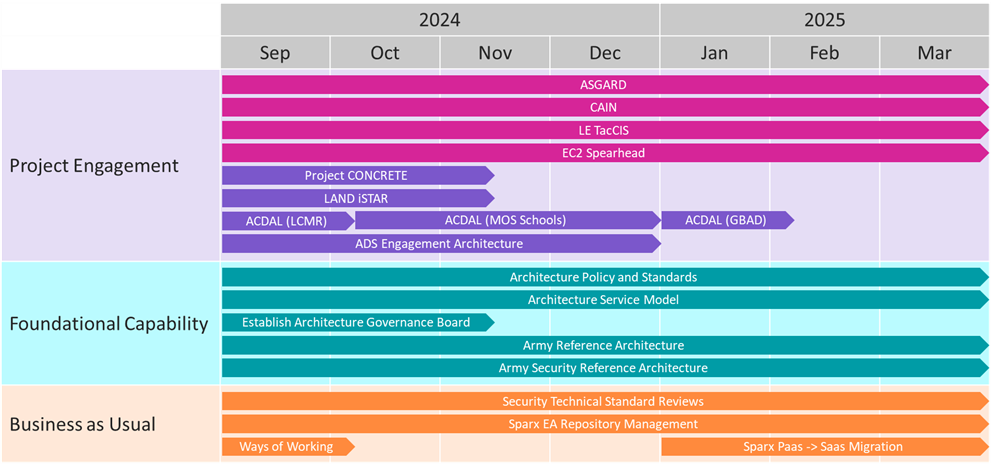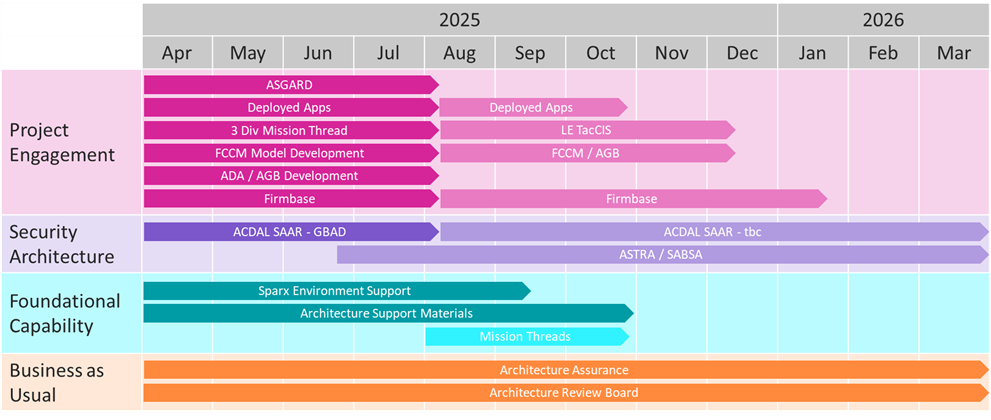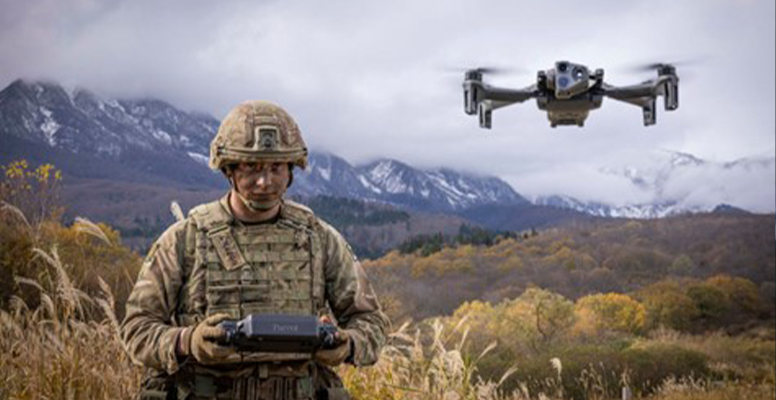22nd June 2025
Modern warfighting requires modular, interoperable capabilities that can be re-configured at short notice. The benefits of adopting an enterprise architecture approach - An Army HQ perspective.
Executive Summary
The Army Information Design Authority (Info DA) has established an Enterprise Architecture function at Initial Operational Capability (IOC). The aim is to model the Army’s digital backbone as a coherent “system of systems” through which information can flow quickly from wherever it is captured to wherever it is needed. Future systems need to be modular, standards based and interoperable to allow the Army to reconfigure assets at short notice and to outcompete our adversaries. In this article we lay out the rationale behind Info DA’s Enterprise Architecture function, report on progress made to date and lay out plans to develop the function to Full Operational Capability (FOC). This paper will highlight the benefits already delivered in year one and outline how Info DA EA will support projects and operations in the future.
Marshall McLuhan
World War III is a guerilla information war with no division between military and civilian participation
'The nature, scale and complexity of the Army combined with how quickly technology evolves means that traditional project and programme management cannot deliver the vision. We must use agile approaches and design thinking along user experiences to drive successful innovation, process optimisation and build on our culture.' The Army Digital and Data Plan 2023 – 2025.
Context – The Threat
The nature of warfare is always changing, and it always will. Warfighting is inherently competitive, and innovation is one way to gain a competitive edge. A modern Army needs to be able adapt and to re-configure quickly to out-compete adversaries and, ideally, get inside the enemy’s OODA (Observe-Orientate-Decide-Act) loop.
The 1990’s saw UK Armed Forces deployed to the Balkans as NATO peacekeepers and to liberate Kuwait as part of a large NATO led coalition. The terrorist attack on the World Trade Centre in 2001 led to a decade of counterinsurgency in Afghanistan and Iraq. Today the threat is a newly assertive Russia fighting an overt war in Ukraine as well as covert cyber and psychological operations. It is impossible to say how the threat will change in the next 10 to 20 years, but it is safe to say that it will continue to evolve, change and become more complex and technology dependant.
Historically, UK Defence procurement has been based on Front Line Commands (FLCs) defining functional requirements and the Defence industry providing the platforms and systems, often in isolation, to meet the stated requirements. Common standards have not been defined or widely adopted, platforms and systems are not architected or understood as a system of systems and so are tightly integrated and inflexible rather than fully modular and wholly interoperable. Bespoke, point to point integration does not allow information to flow through the command structures; it is a tactical solution at best.
Bowman is a good example – a command-and-control system that met the requirements as they were at the time of procurement . Bowman was initially specified in 1989 and delivered into service at IOC in 2004, reaching FOC in 2008, and is expected to continue in service until well into the next decade. Bowman has been extended and upgraded to deliver capabilities in response to evolving technology and threat landscapes, but changes have been slow and expensive in part due to the proprietary architecture on which it was built. Bowman is relatively tightly vertically integrated by design, making it more complex to replace current components with those from third party vendors.
Its planned successor, Morpheus – a £3.2bn Defence programme - was announced in 2016. It has since been absorbed into the Land Environment Tactical Communications and Information Systems (LETacCIS) programme, which aims to deliver an information eco-system including command and control that is inherently modular, standards based and agile by design. Critically, it seeks to adopt an ‘open architecture enabling interoperability by design’ approach that will ‘improve end-to-end shared situational awareness from the soldier to the HQ’.
Enterprise Architecture
Army HQ recognises the need for future platforms, especially C5ISR systems, to be based on common standards and built from modular components. Mission threads will be enabled by operationally focused systems built quickly to support British Army units to achieve outcomes fighting alongside Allies facing a threat landscape that is novel and dynamic.
For this to happen, the Army is increasingly taking responsibility for defining the architectures on which future systems are built, selecting international standards where they exist and specifying Army wide reference architectures where necessary. These core architectures will form part of the requirements for future systems, so that interoperability and modularity are designed and built in.
Enterprise Architecture (EA) is a strategic approach that aligns an organisation’s business goals with its technology and IT infrastructure. It embeds an holistic view of the enterprise (aka future platform fleet), enables joint decision making, resource optimisation and, critically, an engineering baseline that is adaptable to the changing environment and operational needs.
The relationship between Enterprise Architecture and systems procurements can be viewed like the relationship between town planning and development. Town planners consider future needs for a city or town to allow for growth including infrastructure needs (roads, railways, utilities and waste disposal) and citizens’ needs (schools, GP surgeries, shops and theatres). Development of individual projects fits into the overall plan, docking into the available infrastructure, which enables it, but doesn’t constrain it. The town plan, if done well, will allow for flexibility and variety between different developments.
-
https://en.wikipedia.org/wiki/Bowman_(communications_system)
-
Command, Control, Communication, Computers, Cyber, Intelligence, Surveillance and Reconnaissance
Enterprise Architecture Support Partner (EASP)
Following a competitive tender, Army HQ – Directorate Information (D Info) selected Civica to be the Army’s Enterprise Architecture Support Partner (EASP). Under a two-year contract, Civica is providing Enterprise Architecture expertise including business, technology, data, information and security architects. The team supports the Information Design Authority (Info DA), led by Chris Griffin – Chief Architect British Army - to establish an enduring central capability to ensure that future systems are designed to a common set of architectures based on pre-defined and agreed standards. They will be modular and interoperable so that the Army can re-configure assets and systems at short notice to take advantage of innovative technologies faster than our adversaries.

Figure 1 Year 1 Plan – Info DA project support and foundational capabilities
The work of the EASP is organised into functional workstreams to demonstrate value and quickly deliver by supporting in-flight programmes and to build enduring capability for the future.
Programmes that Army HQ’s EASP has supported in year 1 include:
-
ASGARD – sense-decide-effect mission thread – maintain operation, data, system and technology architectures to support collaborative development of mission thread.
-
LE TacCIS – Land Environment Tactical Communications Systems – development of threat capability set models and views.
-
PC-C5 – Project Convergence Capstone 5, an interoperability exercise – defining mission threads, processes and capabilities as well as supporting the UK/US exercise planning and execution.
-
Security Architecture Assurance Reviews (SAARs) – SAARs have been conducted for MOD Schools, LCMR, G-BAD, and G-AMB highlighting potential security risk and issues.
Creating high quality architectural models for process, data, technologies and security demonstrates the value of applying architectural best practices. The benefits of architectural models become apparent in the design phase of complex system discussions about who, what and when at each step in a process, i.e. this system passes this information via this communications channel to that system so that these people can decide on an action, which will result in this outcome. Feedback from programme SROs on the benefits of having clear architectures defined has been very positive.
In the future, digital programmes will be expected to include architectural design phases in their plans and to deliver the artefacts themselves. Army HQ’s Info DA team will transition to become an Architecture Governance and Assurance capability setting standards, supporting tooling and facilitating programmes with:
-
An enterprise grade architecture repository certified for Official-Sensitive (O-S) and Secret architectural artefacts.
-
Architecture policies and standards so that programmes are all working to common standards.
-
Re-usable reference architectures.
-
Architecture assurance services.
-
Architecture Review Board.

Figure 2 - The Year 2 plan – Info DA EASP roadmap for Enterprise Architecture to mature to Full Operational Capability
In year 1 progress has already been made in all these areas. The lessons learned from supporting projects such as LE TacCIS and ASGARD have informed the development of these foundational capabilities, and that feedback from projects to the Info DA will be maintained in the future. The Sparx EA repository is well established and used by all the projects that the EASP team has supported. It is currently certified at O-S, with plans to certify an instance for Secret in year 2 along with a secure interface for sharing models between DE&S and Army. A draft Security Reference Architecture and accompanying Assurance Service have been developed as a priority and been applied to military schools, giving valued assurance that their applications are compliant with the Secure by Design principles. The EASP team has supported the adoption of Force-Centric Capability Management (FCCM), helping to enable vertical enterprise architectural coherence from Army strategy and business to Army information and technology.
Success story - ASGARD showcase
Under direction, Army HQ’s EASP team supported Project ASGARD with architecture expertise in the bounding and validation of the steps and components in a sense-decide-effect mission thread to address a threat in Estonia as part of the British Army Forward Land Forces (FLF) contribution to NATO. Process, data and technology architects worked closely within the ASGARD core team and directly with Army personnel as well as system and technology providers to map and validate the architecture of the full operational process.
The ASGARD mission thread begins with the detection and identification of a threat using a First Person View (FPV) drone. Details of that threat, including a digital fingerprint are passed to the Brigade Headquarters where commanders evaluate the threat and then share the intelligence with Field Army HQ, who decide whether to act and which asset (or effector) to deploy. The digital fingerprint is passed to the effector, in this case another drone so that the threat can be located and its identity confirmed before the command to engage is issued. The goals for the ASGARD mission thread include augmenting the human in the operational process, increasing the speed of the decision cycle, unlocking an “any sensor, any effector” kill chain and precision of engagement to minimise the risk of collateral damage.

Figure 3 – Modernisation of the battlefield (DE&S website)
Chris Griffin, Chief Architect to the Army, is keen to highlight that the success of ASGARD was down to co-operation between the Army and a wide range of suppliers. “ASGARD has accelerated the development, exploitation and practice of Architecture in the British Army as well as a novel approach to development and management of capability through the Mission Thread architecture approach developed by the Info DA architecture function. This has been achieved through a genuine ‘one team’ ethos between Army and Civica staff. I am grateful to the team for their support to me and ASGARD.”
The architects’ role was to model the different levels of architecture, the operational process, the technologies involved and the data that is transferred at each stage. Civica architects maintained the complete architecture while the different partners adopted an iterative approach to integrating the technologies and refining the process. A demonstration was held recently in Blandford for the Chief of the General Staff, General Sir Roland Walker, who described the capability as ‘a game changer’.
Benefits & Summary
In summary, Army HQ has established an Enterprise Architecture function at IOC and proven its value by supporting high value projects including ASGARD and LETacCIS. The primary benefit to these projects is that the resulting systems will be modular by design and built on common standards; ensuring system of system coherence and understood by the Army itself in a central repository of “truth”. Adaptability will be designed in. Suppliers of new components will have the benefit of defined standards with which they can integrate novel technologies.
Experience in EASP Year 1 has also shown that clear architectural models accelerate detailed design and build phases and enable genuine collaboration across the supply chain.
EASP Year 2 will see the capability move to FOC, supporting projects and programmes with architectural services and reference architectures. The aim will remain to ensure that future capabilities can adapt at pace to the ever-changing threat landscape so that the British Army can outcompete its adversaries.
This article was first published in The Journal The Wire & The Journal | Royal Corps of Signals.